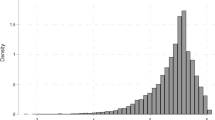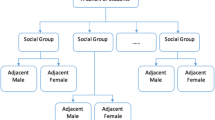Abstract
This paper studies the effects of tracking on student effort and academic achievement during secondary school. Students under the comprehensive school system make effort to increase their academic achievement that determines the probability of gaining admissions to college. As college admissions become less competitive or it becomes easier to gain admissions, it increases the benefits of effort, encouraging more effort. Those students streamed into academic tracks at early ages under tracking are most likely to be admitted to college, and the competitiveness of college admissions does not affect their effort. As a result, tracking tends to perform worse in terms of average secondary-school academic achievement, as higher education expands and college admissions become less competitive.

Similar content being viewed by others
Notes
Tracking occurs even in these countries. For example, in the US, schools often offer various gifted programs at all levels. However, such tracking occurs within a school (Epple et al. 2002), and is not the focus of this paper.
Duflo et al. (2011) study the effects of tracking on teachers’ incentives and effort to teach.
\(n\) may well be endogenously determined by economic and social environments. For instance, economic conditions or economic policy goals may dictate an increase or a decrease in the pool of skilled labor and the number of college admissions. As another example, as society becomes more inclusive or more democratized, the demand for higher education would increase. However, the determination of \(n\) endogenously as an equilibrium of economic and social conditions is beyond the scope of this paper and left for future research.
Period 2 actually includes the time after college, which may be called period 3. However, it is not necessary to create period 3, because the analysis concerns academic achievement during secondary school, as will become clear below.
Alternatively, when the college entrance exams are required, students may fail to pass the exams.
A normal distribution of \(\epsilon \) will be discussed later.
This assumption, along with the usual assumptions of \(w_{bb} < 0\) and \(w_{ee} < 0\), is equivalent to concavity of \(w(.)\).
All students are assumed to make effort and study to be admitted to college under C. However, it is straightforward to consider a model in which some students give up college education at time 1 and do not attend secondary school, or a model in which some students prepare to be workers like in the vocational track under T, as analyzed in an earlier version of this paper. Such a model is not pursued here, because it does not affect the nature of the analysis and results while making the presentation more complicated, and because secondary school is compulsory in most countries under consideration that adopt C.
This assumption means that \(a^*\) is endogenously adjusted to \(n\).
The analysis focuses on effort to increase academic achievement, as in the literature, and the vocational track will not be analyzed.
Arguments of functions are and will be omitted (especially in the first-order conditions) for simplicity whenever such omissions do not create confusion.
This assumption may not hold for some students, but will be maintained throughout the analysis, given that students are assumed to make effort and improve academic achievement to gain college admissions. The consideration of those students with \(v < k\) amounts to creating another track from an analytical point of view, as mentioned in Note 9.
The relationship between \(a\) and \(e_1^C\) will be discussed later.
The first-order condition includes the additional term, \([w_e - c_2']e_2'(b)b_e,\) but the term vanishes again due to envelope result.
The idea of students in the academic track having less incentives to make effort may also apply to students in selective colleges. The reason is that the benefit of education in the form of earnings largely depends on college selectivity (Brewer et al. 1999; Black and Smith 2006). Thus, rational students in those selective colleges would have lower incentives to make effort than in less-selective colleges. At the same time, college GPAs also matter in the labor market (James et al. 1989; Rumberger and Thomas 1993), and even those students in selective colleges make effort. Nevertheless, they would make less effort than those in less-selective colleges to the extent that college selectivity is an important determinant of earnings.
Note that \(\partial t/\partial n\) in (12) does not depend on \(a\).
The formulation means that the size of the academic track \(\theta n\) varies with the size of higher education or the number of college students \(n\). For instance, in Germany, the expansion of higher education was accompanied by the expansion of grammar schools and academic tracks in the 1970s (Jürges et al. 2011).
The shape of the probability function in general may differ from that under C, and may be written as \(q(b, t) = (\lambda - t + b)/2 \lambda ,\) where \(\lambda \) is uniformly distributed over \([-\lambda ,\lambda ]\) with \(\lambda > 0.\) This formulation, however, has no effect on the result.
References
Arnott R, Rowse J (1987) Peer group effects and educational attainment. J Publ Econ 32:287–305
Benabou R (1996) Heterogeneity, stratification, and growth: macroeconomic implications of community structure and school finance. Am Econ Rev 86:584–609
Betts J (1998) The impact of educational standards on the level and distribution of earnings. Am Econ Rev 88:266–275
Black D, Smith J (2006) Estimating the returns to college quality with multiple proxies for quality. J Labor Econ 24:701–724
Blanden J, Machin S (2004) Educational inequality and the expansion of UK higher education. Scott J Polit Econ 51:230–249
Bratti M, Checchi D, De Blasio G (2008) Does the expansion of higher education increase equality of opportunities? Evidence from Italy. Labour 22:53–88
Brewer D, Eide E, Ehrenberg R (1999) Does it pay to attend an elite private college? Cross-cohort evidence on the effects of college type on earnings. J Human Res 34:104–123
Brunello G, Giannini M (2004) Stratified or comprehensive? The economic efficiency of school design. Scott J Polit Econ 51:173–193
Card D, Lemieux T (2001) Can falling supply explain the rising return to college for young men? Q J Econ 116:705–746
Costrell R (1994) A simple model of educational standards. Am Econ Rev 84:956–971
Duflo E, Dupas P, Kremer M (2011) Peer effects and the impact of tracking: evidence from a randomized evaluation in Kenya. Am Econ Rev 101:1739–1774
Effinger MR, Polborn MK (1999) A model of vertically differentiated education. J Econ 69:53–69
Epple D, Newlon E, Romano R (2002) Ability tracking, school competition, and the distribution of educational benefits. J Publ Econ 83:1–48
Falch T, Fischer J (2008) Does a generous welfare state crowd out student effort? Panel data evidence from international student tests. Stockholm School of Economics SSE/EFI Working Paper Series in Economics and, Finance No 694
Fryer R Jr, Loury G, Yuret T (2008) An economic analysis of color-blind affirmative action. J Law Econ Org 24:319–355
Glomm G, Ravikumar B (1992) Public versus private investment in human capital: endogenous growth and income inequality. J Polit Econ 100:818–834
Galindo-Rueda F, Vignoles A (2004) The heterogeneous effect of selection in secondary schools: understanding the changing role of ability. Institute for the Study of Labor (IZA). Discussion Paper No. 1245.
Hanushek E, Wößbmann L (2006) Does educational tracking affect performance and inequality? Differences-in-differences evidence across countries. Econ J 116:c63–c76
James E, Alsalam N, Conaty J, To D (1989) College quality and future earnings: where should you send your child to college? Am Econ Rev (Pap Proc) 79:247–252
Jürges H, Reinhold S, Salm M (2011) Does schooling affect health behavior? Evidence from the educational expansion in Western Germany. Econ Educ Rev 30:862–872
Katz L, Murphy K (1992) Changes in relative wages, 1963–1987: supply and demand factors. Q J Econ 107:35–78
Klemm K, Klemm A (2010) Ausgaben für Nachhilfe—teurer und unfairer Ausgleich für fehlende individuelle Förderung. Bertelsmann Stiftung
Lee K (2012) Early selection and moral hazard. Econ Lett 116:139–142
Manning A, Pischke JS (2006) Comprehensive versus selective schooling in England and Wales: what do we know? NBER working paper no 12176
Meghir C, Palme M (2005) Educational reform, ability and family background. Am Econ Rev 95:414–424
Meier V (2004) Choosing between school systems: the risk of failure. FinanzArchiv 60:83–93
Mühlenweg A (2007) Educational effects of early or later secondary school tracking in Germany. Center for European Economic Research working papers, no, pp 07–079
OECD (2010) Tertiary education entry rates. Education: Key Tables from OECD, No. 3. doi:10.1787/20755120-2010-table2
OECD (2013) Education Database: Students enrolled by type of institution. OECD Education Statistics (database). doi:10.1787/data-00211-en
Oppedisano V (2011) The (adverse) effects of expanding higher education: evidence from Italy. Econ Educ Rev 30:997–1008
Pekkarinen T, Uusitalo R, Kerr S (2009) School tracking and intergenerational income mobility: evidence from the Finnish comprehensive school reform. J Publ Econ 93:965–973
Rumberger R, Thomas S (1993) The economic returns to college major, quality and performance: a multivariate analysis of recent graduates. Econ Educ Rev 12:1–19
Schneeweis N, Zweimüller M (2009) Early tracking and the misfortune of being young. The Austrian Center for Labor Economics and the analysis of the welfare state working paper no. 0920
Taber C (2001) The rising college premium in the eighties: return to college or the return to unobserved ability? Rev Econ Stud 68:665–691
Takii K, Tanaka R (2009) Does the diversity of human capital increase GDP? A comparison of education systems. J Publ Econ 93:998–1007
Waldinger F (2006) Does tracking affect the importance of family background on students’ test scores? London School of Economics (unpublished manuscript)
Author information
Authors and Affiliations
Corresponding author
Additional information
I am grateful to three anonymous referees for their very helpful comments that improve the paper significantly.
Appendix
Appendix
1.1 Derivation of the results in Sect. 5.1
With \(Prob\;(\epsilon \ge t-b) = 1 - H(t-b)\), the first-order condition for a maximum of \(U^C(e_1)\) is
The second-order condition is
All terms in (46) are negative, except \(hw_b (b_e)^2\). For the satisfaction of the second-order condition, all other negative terms are assumed to dominate the only positive term. For example, \(c_1(e_1)\) is convex enough or \(b(.)\) is concave enough. Differentiation of (45) gives the expression for \(\partial e_1^C/\partial t\) in (23). If \(\partial e_1^C/\partial t \le 0\) in (23),
If \(\partial e_1^C/\partial t > 0\), using (23) and (46),
All terms in (48) are positive, except \(-hw_b(b_e)^2\). As in the second-order condition in (46), all other positive terms are assumed to dominate the only negative term, for example, by assuming that \(c_1(e_1)\) is convex enough or \(b(.)\) is concave enough. Alternatively, combining this negative term with \(-h(v-k)b_{ee}\), the first term of the numerator of (48),
where \(\sigma \) is the standard deviation of the normal random variable \(\epsilon .\) The inequality comes from \(-hw_b > - h'(v-k)\) when \(\partial e_1^C/\partial t > 0\) in (23). The second equality uses the normal density function with mean zero, \(h(\epsilon ) = \frac{1}{\sigma \sqrt{2\pi }}exp(-\frac{\epsilon ^2}{2 \sigma ^2})\), and \(h'(\epsilon ) = - \frac{\epsilon }{\sigma ^2}h(\epsilon ),\) so that \(h'/h = - \epsilon /\sigma ^2 = - (t-b)/\sigma ^2.\) Equation (49), and hence (48), become positive if \(\sigma \) is large or \(b_e\) is small (effort is not too productive) or \(b\) is concave enough.
Rights and permissions
About this article
Cite this article
Lee, K. Higher education expansion, tracking, and student effort. J Econ 114, 1–22 (2015). https://doi.org/10.1007/s00712-013-0369-x
Received:
Accepted:
Published:
Issue Date:
DOI: https://doi.org/10.1007/s00712-013-0369-x




